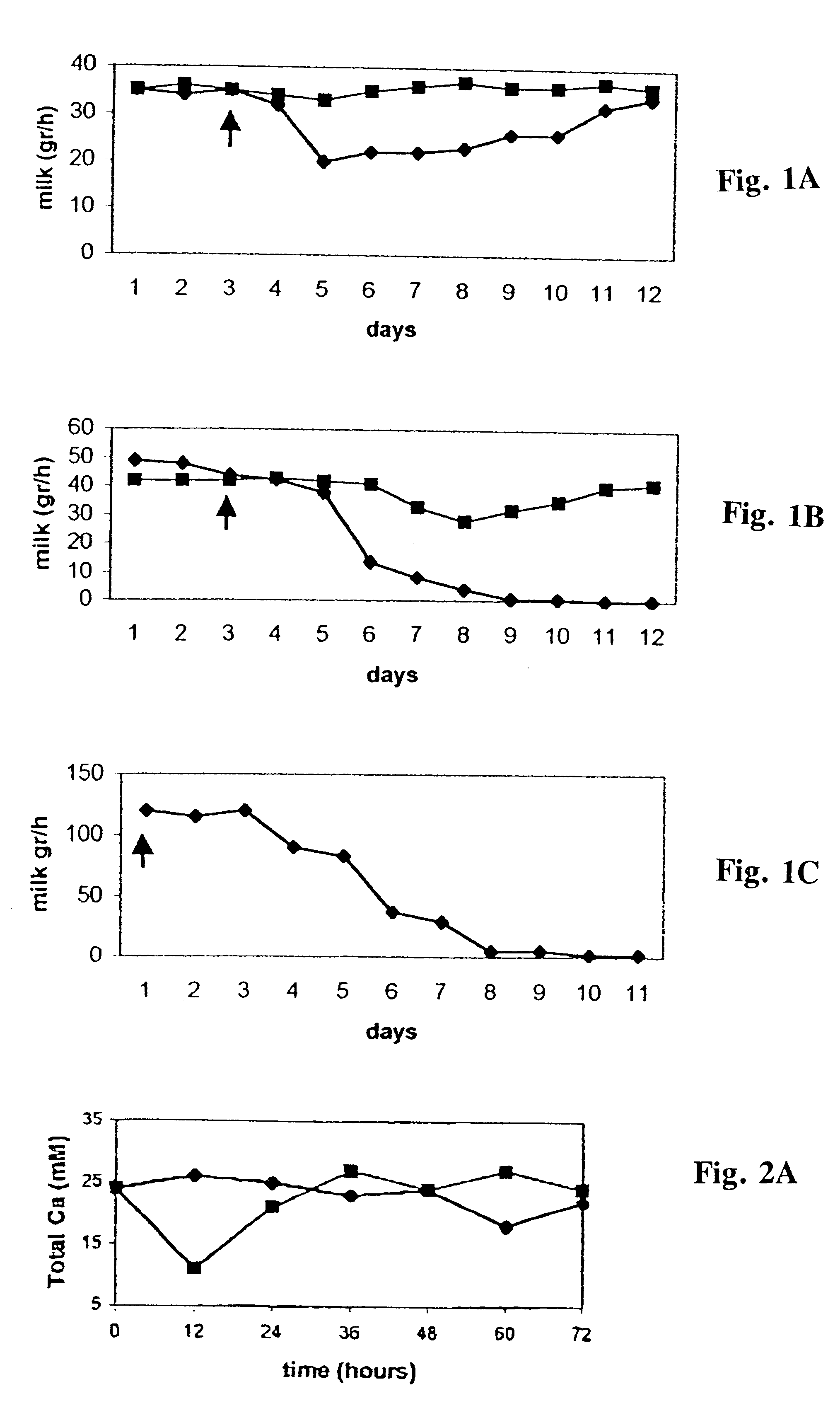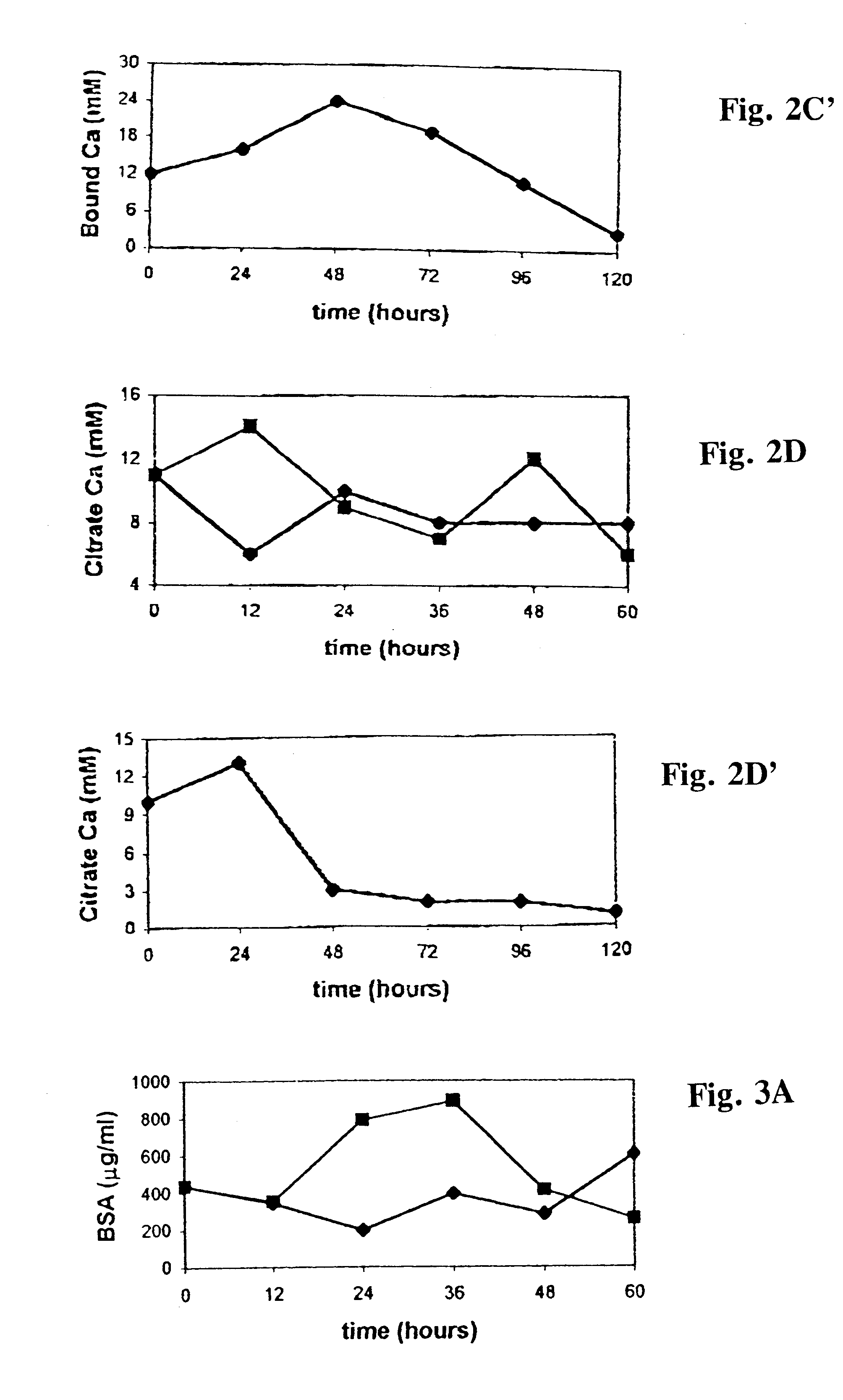Method and pharmaceutical composition for disrupting lactation in a mammary gland and for treating and preventing mastitis
a technology of mammary gland and composition, which is applied in the direction of biocide, hydrolysed protein ingredients, peptide/protein ingredients, etc., can solve the problems of tj becoming leaky, increasing the difficulty of controlling, and significant overlap
- Summary
- Abstract
- Description
- Claims
- Application Information
AI Technical Summary
Problems solved by technology
Method used
Image
Examples
example 1
Milk Production Declines as a Result of PP Injection into the Lactating Mammary Gland
After injection of PP to the teat as described hereinabove, milk secretion declined by 40% relative to pretreatment data. In cases where a single gland was treated once, the parallel contralateral gland remained unaffected (FIG. 1a). In the single treated gland, the depression in milk secretion was transient, and took 7 days for complete recovery. Six treatments of a single gland after each milking. caused milk secretion in the treated gland to decline at an accelerated rate and after 94 hours only a few milliliters of milk could be harvested from the gland (FIG. 1b). The pattern of decline of milk secretion in a goat in which both glands were treated with PPs was similar to the one recorded in a single treated gland (FIG. 1c). These results indicate that a single treatment with PP can cause a transient, reversible, cessation of milk production, but that repeated treatments cause an irreversible ces...
example 2
Milk Composition Following a Single Dose of PP
Determination of the concentration of various milk components after a single injection of PP to the teat canal was conducted. Following the first milking 12 hours subsequent to the injection, a sharp decline in the total (FIG. 2a) and ionized (FIG. 2b) concentrations of Ca in milk was observed. This effect was transient, and at 24 hours post-treatment the total and ionized Ca concentrations in the milk returned to the pretreatment values. Bound calcium (FIG. 2c), citrate calcium (FIG. 2d) and casein (FIG. 4b) did not change significantly compared to the pretreatment values in the single dose experiment
At 36 hours post-treatment, the concentration of lactose and K.sup.+ (FIGS. 3b and 3c, respectively) dropped sharply, concurrent with an increase in Na.sup.+ concentration (FIG. 3d). The concentration of these metabolites returned to pretreatment values after 48 hours. The pattern of changes in the concentration of BSA (FIG. 3a), whey prote...
example 3
Milk Composition Following Multiple Doses of PP
Determination of the concentration of various milk components in response to multiple injections of PP to the teat canal was conducted. Beginning 24 hours post-treatment, the concentration of total calcium declined steadily, and stabilized after 96 hours at 6 mM, a value which was 4 times lower then the pretreatment value (FIG. 2a'). The pattern of changes in total magnesium and phosphorus was similar to that of total calcium (data not shown). Magnesium concentration was stabilized after 96 hours at 2 mM, and that of phosphorus at 7 mM, these values were 3 (magnesium) and 4 (phosphorus) time lower then the pretreatment values. A drop in Ca.sup.+2 concentration was apparent after the first milking (12 hours post-treatment), and its concentration declined steadily, and stabilized after 96 hours at 0.6 mM, a value which was 5 time lower then the normal-pretreatment value (FIG. 2b'). The concentration of Ca bound to casein increased up to 4...
PUM
 Login to View More
Login to View More Abstract
Description
Claims
Application Information
 Login to View More
Login to View More - R&D
- Intellectual Property
- Life Sciences
- Materials
- Tech Scout
- Unparalleled Data Quality
- Higher Quality Content
- 60% Fewer Hallucinations
Browse by: Latest US Patents, China's latest patents, Technical Efficacy Thesaurus, Application Domain, Technology Topic, Popular Technical Reports.
© 2025 PatSnap. All rights reserved.Legal|Privacy policy|Modern Slavery Act Transparency Statement|Sitemap|About US| Contact US: help@patsnap.com



